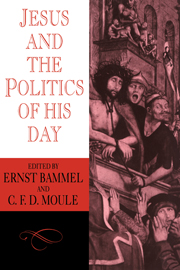Book contents
- Frontmatter
- Contents
- Abbreviations
- Foreword
- The Zealots and Jesus
- The revolution theory from Reimarus to Brandon
- The date and character of Mark
- Some observations on Tendenzkritik
- Argumentum e silentio
- The Poor and the Zealots
- The opposition between Jesus and Judaism
- Judaeo-Christianity and the Jewish establishment, A.D. 33–66
- A.D. 70 in Christian reflection
- The trial of Jesus in the Acta Pilati
- Christ as brigand in ancient anti-Christian polemic
- Jesus as a political agent in a version of the Josippon
- The Feeding of the Multitude
- The coin of ‘Render unto Caesar …’ (A note on some aspects of Mark 12: 13–17; Matt. 22: 15–22; Luke 20:20–26)
- Render to Caesar
- The Temple tax
- ‘Not peace but a sword’: Matt. 10:34ff; Luke 12: 51ff
- The decision of the Supreme Court to put Jesus to death (John 11:47–57) in its context: tradition and redaction in the Gospel of John
- The ‘triumphal’ entry
- The two swords (Luke 22: 35–38)
- The titulus
- Romans 13
- Biblical criticism criticised: with reference to the Markan report of Jesus's examination before the Sanhedrin
- The political charge against Jesus (Luke 23: 2)
- The trial before Pilate
- ‘His witness is true’: A test of the Johannine claim
- Index of Authors
- Index of References
Biblical criticism criticised: with reference to the Markan report of Jesus's examination before the Sanhedrin
Published online by Cambridge University Press: 19 January 2010
- Frontmatter
- Contents
- Abbreviations
- Foreword
- The Zealots and Jesus
- The revolution theory from Reimarus to Brandon
- The date and character of Mark
- Some observations on Tendenzkritik
- Argumentum e silentio
- The Poor and the Zealots
- The opposition between Jesus and Judaism
- Judaeo-Christianity and the Jewish establishment, A.D. 33–66
- A.D. 70 in Christian reflection
- The trial of Jesus in the Acta Pilati
- Christ as brigand in ancient anti-Christian polemic
- Jesus as a political agent in a version of the Josippon
- The Feeding of the Multitude
- The coin of ‘Render unto Caesar …’ (A note on some aspects of Mark 12: 13–17; Matt. 22: 15–22; Luke 20:20–26)
- Render to Caesar
- The Temple tax
- ‘Not peace but a sword’: Matt. 10:34ff; Luke 12: 51ff
- The decision of the Supreme Court to put Jesus to death (John 11:47–57) in its context: tradition and redaction in the Gospel of John
- The ‘triumphal’ entry
- The two swords (Luke 22: 35–38)
- The titulus
- Romans 13
- Biblical criticism criticised: with reference to the Markan report of Jesus's examination before the Sanhedrin
- The political charge against Jesus (Luke 23: 2)
- The trial before Pilate
- ‘His witness is true’: A test of the Johannine claim
- Index of Authors
- Index of References
Summary
In the introduction to the third edition of his Neutestamentliche Methodenlehre Heinrich Zimmermann writes that he has not mentioned religio-historical study among the methods of scholarly New Testament interpretation, because he does not know ‘which New Testament pericopae could be chosen as examples, from the point of view of the history of religions’, to demonstrate its use and applicability. His book is accordingly for the most part a full and highly instructive presentation of literary-historical methods, particularly form-criticism and redaction-criticism. The traditions which are shaped in transmission and combined in redaction have nevertheless an historical background. In form- and redaction-criticism this is virtually excluded from examination. These methods are concerned primarily with the moulding of the traditions by congregational Sitz im Leben and editorial outlook. Enquiry is directed at the process of literary formation rather than the historical background from which the process begins. Heinz Schürmann justly observes that enquiry into the Sitz im Leben of the congregations which proclaimed the Gospel is too limited in scope for him to say that his acceptance of the Gospel is vindicated by it. If, for instance, the Gospel statements on Jesus are to be interpreted only in the light of Easter and Whitsuntide, and cannot be ‘traced back to the historical Jesus and into the company of the disciples before Easter’, the Christian message would lose ‘the factum historiam’ which is its basis, and could accordingly ‘no longer be distinguished from Gnosis’.
Kurt Lüthi, in his review of Adolf Holl's Jesus in schlechter Gesellschaft, sums up by saying that New Testament study has foregone ‘any direct apprehension of Jesus’.
- Type
- Chapter
- Information
- Jesus and the Politics of his Day , pp. 385 - 402Publisher: Cambridge University PressPrint publication year: 1984

